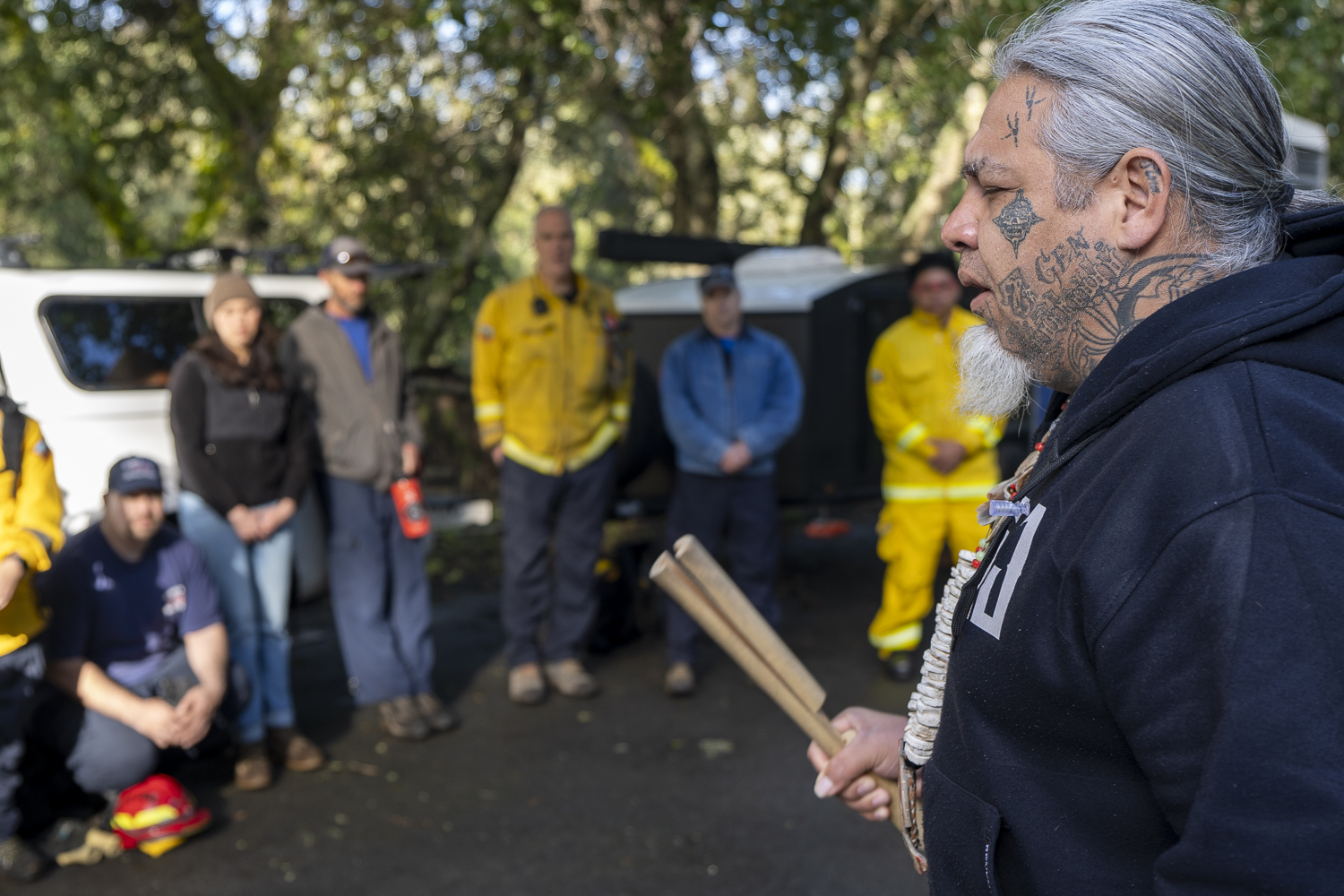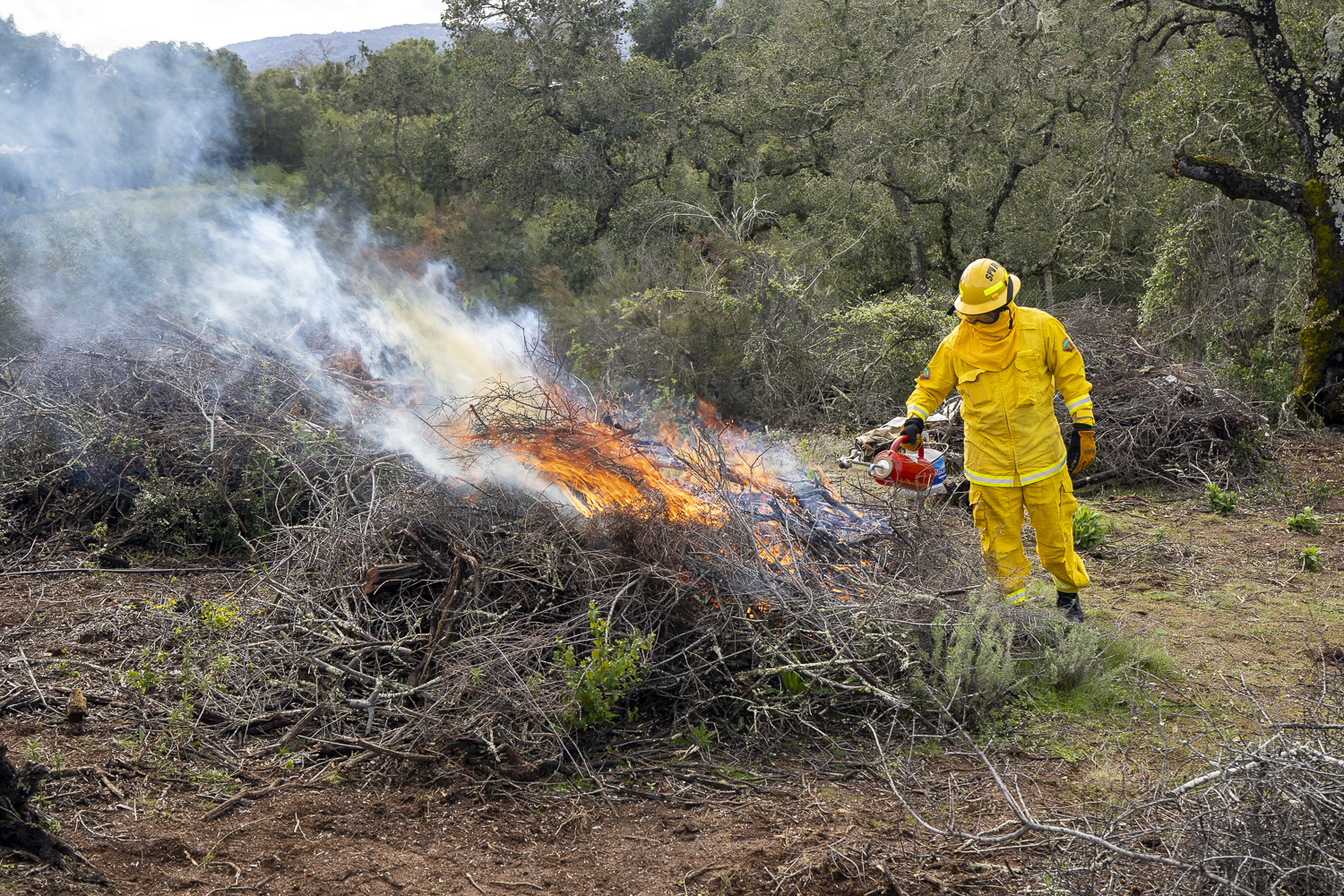Under a blue morning sky, thin white smoke floated up from sage burning in an abalone shell as Joey Iyolopixtli Torres, a member of the Muwekma Ohlone Tribe of the San Francisco Bay Area, rhymically shook a clapstick and provided a blessing in the native Chochenyo language for a burn crew at the Jasper Ridge Biological Preserve ('Ootchamin 'Ooyakma).
'Ootchamin 'Ooyakma means red ridge or mountain. It serves as the translation of “Jasper Ridge” in the Muwekma Ohlone Chochenyo dialect.
Soon, the burn crew, consisting of professional firefighters and trained fire personnel, would carefully set 4- to 6-foot-tall piles of brush ablaze in the chaparral at Jasper Ridge, sending dark plumes of smoke high into the air as orange-hued fire loudly crackled below.
“We are finding connection to the land by opening it up with sacred fire. The fire is life,” said Torres, spiritual advisor for the Tribe. “There’s a spirit to this and a spiritual connection to everything we do. This burn is all part of an ecosystem and part of the changing of the cycles to spring as we want everything to grow back.”
Charlene Nijmeh, chairwoman of the Tribe, said fire brings back a balance and revitalization to the land that the Tribe has long been disconnected from as a result of colonization.
“We are connecting back to our land and learning the old ways and traditions of our ancestors,” Nijmeh said. “This fire is part of that process.”
Spring renewal
The pile burning at Jasper Ridge, conducted over four days in March, represents a shift in the preserve’s approach to wildfire prevention to “two-eyed seeing” that uses both Indigenous and Western practices. Tadashi Fukami propelled the shift to this style, which also prioritizes working closely with the Muwekma Ohlone Tribe and other Indigenous entities, when he was named faculty director of Jasper Ridge, a unit of the School of Humanities and Sciences, last year.

We are connecting back to our land and learning the old ways and traditions of our ancestors. This fire is part of that process.”
For millennia, Indigenous tribes conducted low-intensity fires for land stewardship and cultural practices. In recent decades, perceived fire risk led California and other states to stop using prescribed fires and focus only on fire prevention, which resulted in a present-day buildup of vegetation, explained JRBP staff scientist Sheena Sidhu.
This intervention interrupted ecological cycles managed by Indigenous people and has contributed to increasingly intense wildfires.
“We can assume that a fire will come through at some point,” Sidhu said. “By burning fuel, we’re eliminating it from the environment in a controlled way that has ecological benefit, versus an uncontrolled intense or catastrophic wildfire.”
Research has found that low-intensity fire in California’s mixed conifer forests initially provides a 60% reduction in risk of catastrophic fire, and that this protective effect lasts at least six years.
JRBP previously conducted a few small controlled burns in 2001 and 2011, and also used goats to reduce fire fuels. In October, crews took the first step in conducting a larger controlled burn by removing dead and dying vegetation, some of which hadn’t been touched in nearly a century, and thinning healthy vegetation across approximately 85 acres. This created a shaded fuel break ranging between 100 to 300 feet into the preserve along the fence line at Sand Hill Road and the preserve’s Westridge neighborhood boundary.
Crews cut and chipped vegetation in some areas, and in steeper areas inaccessible to machinery, they created large piles of cut vegetation. Those piles were then burned in early March under a CAL FIRE burn permit with support from both CAL FIRE and the Woodside Fire Protection District.
Pile burning is an effective technique for improving wildfire resilience by reducing the amount of vegetation on the landscape with minimal impact. Regular burns can also help enhance ecosystem integrity by renewing soils, seed banks, and vegetation as a natural part of their lifecycle, Sidhu explained.
“We can do fire in an ecologically sensitive way,” she said. “We don’t need to mow down everything or cut down all trees to make it safe. You just need proper spacing.”
Facts about the 2024 pile burn
The work is part of the 2021 Stanford University Wildfire Management Plan informs how fuel reduction for wildfire mitigation is conducted on all university lands. The pile burning follows the Jasper Ridge Recommendations for Merging Fire Fuel Mitigation with Stewardship Practices white paper, which was developed by more than two dozen experts in the areas of wildfire modeling, fire emergency response, land management, risk management, Indigenous practice, research, education, policymaking, law, and ecology.
“We want to be on the leading edge of this and go further beyond what’s just legally required by the state of California,” said Kevin Irwin, senior project manager in Land, Buildings & Real Estate (LBRE), which partnered with Jasper Ridge on the plan.
A National Wildfire Coordinating Group-certified “Burn Boss” who specializes in these types of burns oversaw the March fire, which was also carried out with guidance from local fire agencies. Firefighters snaked a hose through the pile burn area and set up a portable water tank while continually monitoring changing weather conditions such as wind and smoke dispersion to ensure safety.
Crews also took care to avoid sensitive biological areas, and one pile was not burned after staff observed a nesting woodrat. Staff talked to neighbors for months in advance of the burn and regularly checked in with them during the fire to answer any questions or address concerns. One neighbor generously allowed firefighters to run a hose through her yard and for a night patrol member to stay on her property while watching the fires.
“Fuel reduction has to be at the community level since neighbors rely on one another, and fire is not going to stop at a property line,” Sidhu said. “So we’re doing this collectively and then following up with education and outreach. For years people didn’t know terms like ‘defensible space’ or ‘home hardening,’ and now those are common terms. It’s an indirect benefit just adding to the cultural and community discussion and education about wildfire risk mitigation.”
A living lab
The pile burning also provided researchers with the opportunity to conduct studies under real land management conditions and contribute to a better understanding of effective wildfire management.
“It’s kind of a perfect marriage of stewardship for the university’s land and its research,” Irwin said.
Many students and faculty didn’t have access to a prescribed burn for research before, said JRBP Executive Director Jorge Ramos. “This follows Jasper Ridge’s mission by offering research, education, and stewardship activities, which I think will give the biggest bang in the long term,” Ramos said.
Researchers collected pre- and post-burn data, and they will be testing long-term impacts of fire and smoke on soil and small mammals, Sidhu said.
“There’s a lot of interest in this, but because wildfires have been so intense, it’s been very reactive with researchers going to where fires have happened,” Sidhu said. “This gives a little bit more space to do it in a controlled way. There certainly is a need to fill in this research gap about what’s the best way to mitigate fuels and fire risk in our area.”

By burning fuel, we’re eliminating it from the environment in a controlled way that has ecological benefit, versus an uncontrolled intense or catastrophic wildfire.”
Michael Wilcox, a senior lecturer in Native American studies at Stanford and tribal historic preservation officer for the Muwekma Ohlone Tribe, brought students in his native garden class to the first day of the pile burn. They also spent time with Monica V. Arellano, former tribal vice chair, and Gloria Arellano-Gómez, former tribal council member, who offered a prayer in the native Chochenyo language as firefighters set a pile on fire.
“This Chochenyo prayer is given in thanks and in blessing of the burn on behalf of our people,” Arellano-Gómez said. “Our spoken prayer is bringing life back into the land, and it’s always an honor and very powerful when we do it on our ancestral homeland and as part of amazing projects like this.”
Zander Opperman, ’25, is studying biology with a focus in ecology and is a living lab fellow at the Stanford Doerr School of Sustainability. Last fall, he volunteered on some controlled burns with the Central Coast Prescribed Burn Association.
Opperman assisted Sidhu in mapping the pile burns at JRBP, and he’s studying the transport and presence of heavy metals, such as chromium, within the piles and, in particular, how they transformed after the burn. Using temperature probes, he will also look at changes in the soil chemistry.
“Having good fire on the land is important to having healthy landscapes where communities can thrive,” Opperman said.
As embers cooled from the nearly 200 piles burned in March, they left white ashen circles scattered throughout the hills at JRBP, ready for spring rains and green growth.